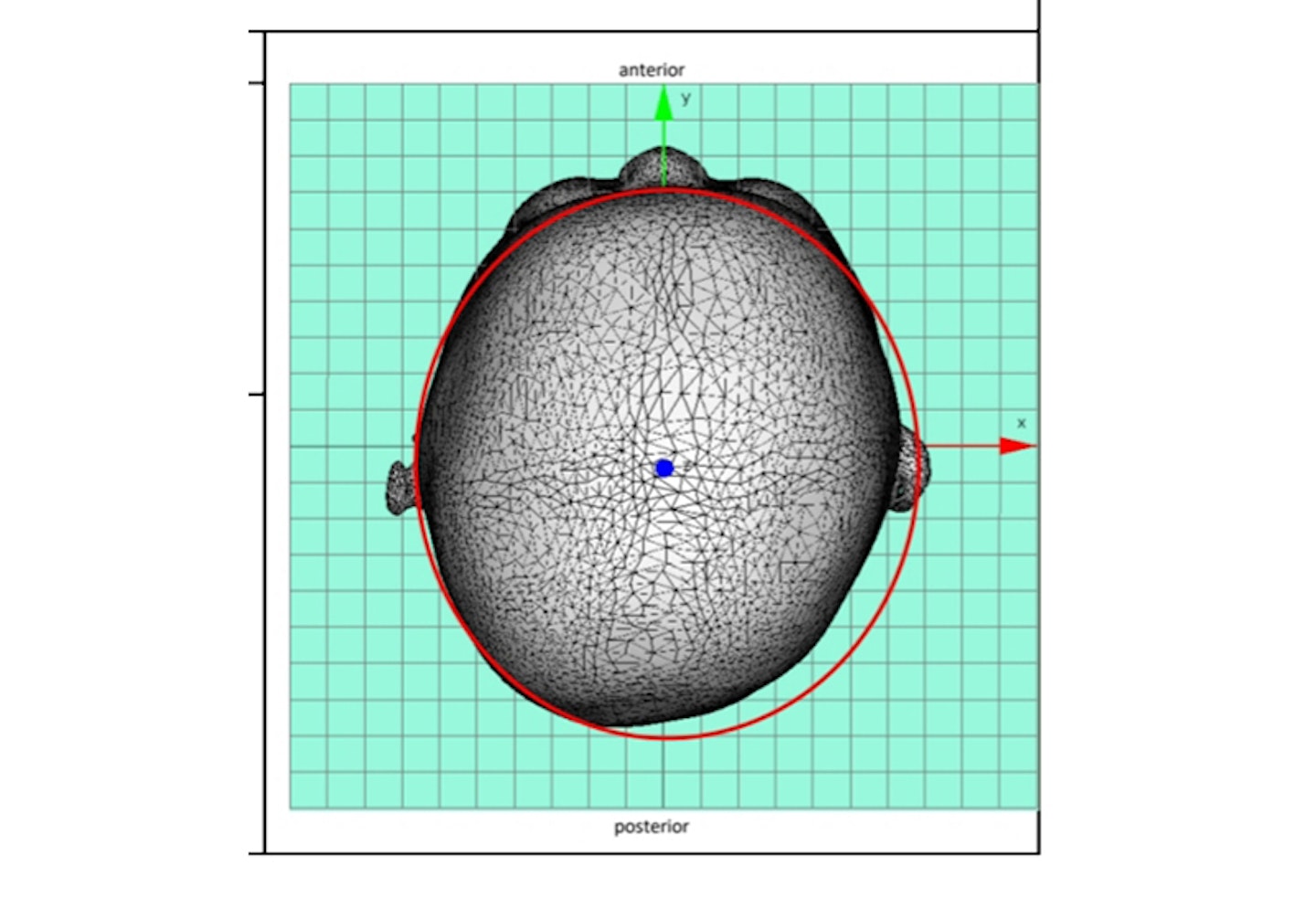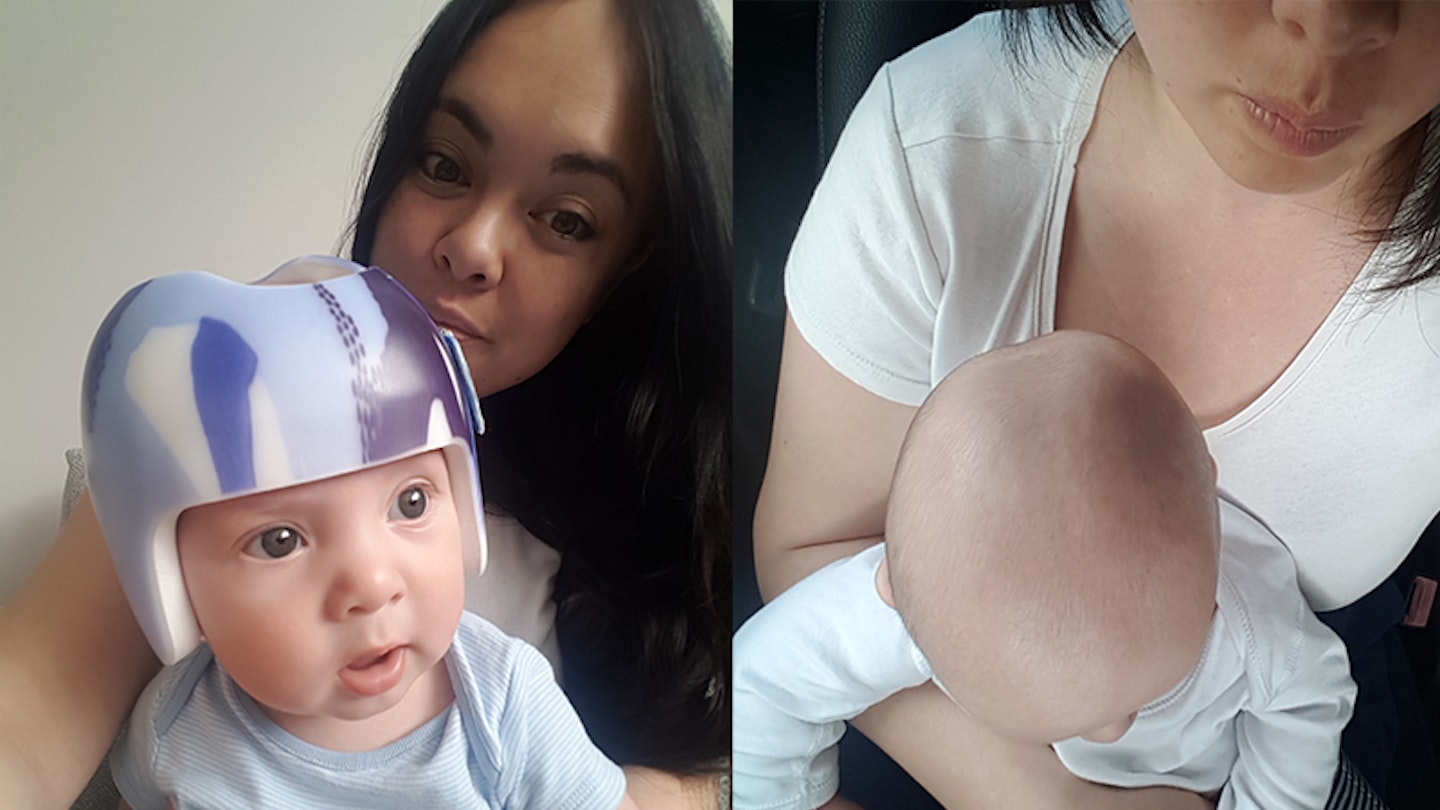Flat head syndrome, also known as Plagiocephaly (side of the head is flatter) or brachycephaly (if the flat spot is on the back of the head), occurs in about 50 per cent of children, however is not very well known in the UK.
While the condition is characterised by a flattening on one side or the back of the head, it may also involve bulging of the forehead, fullness of the cheek and ear misalignment on the same side as the flattening.
Newborn babies often have some asymmetry of the head, since the bones in the skull have not yet fused together. That’s why tummy time and alternating your baby’s head position is so essential to your baby’s development.
Plagiocephaly usually fixes itself as your baby grows, but sometimes treatment is needed such as helmets and using special pillows.
These devices apply pressure to ‘bulging’ parts of the skull and relieve pressure from other parts, potentially allowing growth in the flatter areas.
Treatment is started when the child's skull is still soft, usually at around 5 or 6 months old, and the device is worn almost continuously (up to 23 hours a day) for several months.
Once a baby is 18 months the head is fused and the only way to correct a misshapen head is by surgery.
However, these helmets and headbands generally aren't recommended by the NHS because of the cost involved, and the lack of clear evidence to suggest they work.
Lucy Best from Hampshire Orthotics is mum to three young daughters, and an orthotist with 20 years experience, we spoke to her about the helmet treatments she offers and why the NHS don’t endorse it.
“It’s true the NHS don’t recommend helmets for treatment of Plagiocephaly, however they recognise that severe cases are likely to be noticeable when the baby grows up. They say there is a lack of research but in my experience there is plenty to show that helmets are effective.”
Why might a baby need helmet treatment?
Helmets are recommended for those with severe Plagiocephaly which will be noticeable when the child grows up. Lucy adds, “I assess babies and if they are mild then I say no helmet needed because it won’t be noticeable on an adult head. About 22 per cent of babies I assess don’t need a helmet and I give them repositioning advice only.
“You can liken it to orthodontic teeth braces,” explains Lucy, “it is acceptable to have them for cosmetic reasons only. These helmets are for cosmetic reasons only – although this can also be psychological, for example if child/adult is unhappy with their head shape which can affect the ears and face in severe cases.”
Cost of treatment
Since you have to go private for helmet therapy, the treatment doesn’t come cheap at £2,500, but there are charities that can help with funding, such as headstart4babies. Some parents use GoFundMe too.
To reassure parents further, Lucy offers a 100 per cent money back guarantee if there’s no significant improvement. “All the babies I have treated with helmets (over 120 now) have had significant improvements. Once a baby is fitted with a helmet, they have regular checks and if there is any pressure areas they come for an adjustment.”

"I did the repositioning and stretches religiously"
Mei’s 6-month-old son Byron is currently having helmet therapy for Plagiocephaly at Lucy’s practice.
“I first noticed Byron had a flat spot when he was about 3.5 months old,” says Mei. “My health visitor mentioned that he was not turning his head to the left and he favoured his right side. She told me to just keep playing with him on his left side and that was it.
“I did a bit of research and found that this favouring of one side could cause a flat spot, so I checked over Byron’s head and indeed it seemed flat on the back right side. I also noticed from above his head looked an odd shape.
“I booked an appointment with the GP, and was told they thought he had Plagiocephaly and Torticollis - a twisting of the neck that causes the head to rotate and tilt at an odd angle. They said it was mild and would resolve on its own, and to keep turning him around in his crib and to relax, it's ok to let him lay on his flat side.
"I wasn't happy with this and saw another GP but they said a similar thing, that he would grow out of it and that there was nothing wrong with his neck etc. I really didn't feel that they checked properly or understood the condition and I was not satisfied with just leaving it there." So Mei looked for a private specialist.
“When Lucy first saw Byron at 4 months old she measured him at 11mm Plagiocephaly (moderate Plagiocephaly), she also noticed he couldn't fully turn his head to the left. First she gave us physiotherapy exercises to do 5 times a day to stretch his neck muscles. She advised us to try this for 1 month, along with repositioning off the flat side and plenty of tummy time, to see if it would resolve on its own.
“I did the repositioning and stretches religiously, I also used a special pillow for flat head syndrome (Mimos pillow) for when we needed to lay him down on his back for nappy changes, supervised daytime naps and playmat time. I also increased his tummy time. But when we went back a month later (3 weeks prior to helmet) his measurements hadn't improved, they had gotten worse to 12mm Plagiocephaly (top end of Moderate Plagiocephaly).
“I was really shocked and upset that after all that effort it had not worked. When we got home I cried and said to my partner I think he needs the helmet. My partner was happy to go along with whatever I decided for him but was not pro-helmet, so I really felt the weight of the decision was on me!
“I took the weekend to think it over and thought if that was me as an adult with an odd shaped head, I would have wished my parents would have done something when they could. I know I would regret not trying and didn't want his head to get worse.
“I went back the following week with Byron for his scan, and then it was a 2 week wait for the helmet. When we got the helmet he was 5.8 months old and measured 14mm asymmetry by then (Severe Plagiocephaly). This further confirmed to me I made the right choice as it was getting worse.
"The helmet doesn't bother Byron at all"
“You have to wean your baby on to using the helmet over the course of 5 days. By day 3 Byron was happily napping and sleeping in the helmet. He has to wear the helmet for 22-23 hours a day, and I expect him to be in the helmet for 3-4 months. It doesn't bother him at all, it’s just like another piece of clothing for him.
"At our 1 week check up on day 7 he had improved from 14mm to 12mm. At our latest appointment he’s down to 9mm, which is considered mild, just from three weeks of wear, Normal is 6mm and under. I’m so pleased with the progress he’s made.
"No one knows what the helmet is for"
“I didn’t get told about Plagiocephaly during my pregnancy, there are no leaflets to show what could happen and what to look out for. All I was told was to keep turning your baby around in the crib and switch feeding arms.
“This did not work in my case due to the torticollis, so during Byron’s sleep or when on his back he would turn his head the same way. Being a naive first time mum I didn't catch it all early enough, perhaps if I caught the neck issue early his head would have rounded out naturally.
“When I speak to people about Byron’s helmet therapy, almost nobody knows what it’s for. On my social media posts I get quite a lot of comments from parents who were told their baby’s flat head would go away on his own, but it didn’t improve and now their child is too old for helmet therapy.
“I wanted to share my story to raise awareness to parents that flat head syndrome is very real, if you catch it early you can reverse or prevent it, but if not there are treatments to help.”
When to get medical advice
If you're concerned about flat head syndrome, speak to your health visitor or GP, or seek out a specialist orthotist. They can examine your baby's head and suggest things you can do to help.
A slightly flattened head isn't usually anything to worry about, but it's a good idea to get advice early on so you can take steps to stop it getting any worse.
